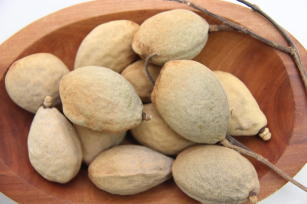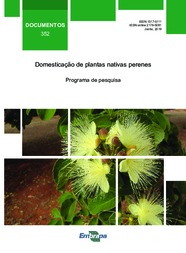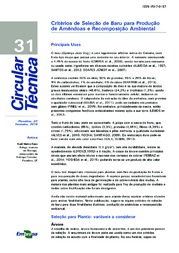A native tree from the Cerrado that is only found in South America, the baru tree can supply timber and an edible seed, baru. Research has been developing a baru production process in integrated crop-livestock-forestry systems. Similar to a nut, the market value of baru has been increasing, as it is sought after by national and international cuisines. Half of the national baru production is exported; exports are divided especially between the United States and Europe. The use of baru in integrated crop-livestock-forestry systems is a more interesting option for farmers than monoculture. Present production is still mainly extractivistic. The baru tree (Dipteryx alata), which is native to the Cerrado biome, is one of the most promising native species for use in integrated crop-livestock-forestry systems, in which grain crops, trees and herds are produced in the same space. Presently, the eucalyptus tree is the most widely used one in these systems. However, the baru tree has an advantage: in addition to the wood that the tree produces, it also produces a valuable seed. The baru, cumaru or cumbaru, as it is locally known, is similar to a nut, and demand for it has increased for the last few years in Brazil and abroad. Consumption is forecast to grow 25% a year for the period between 2019 and 2029, according to an article published in the market research journal Fact.MR. Brazil is the main country to produce this species. Almost half of the seeds produced is sold abroad, 25% to Europe and 22% to the USA. One of the reasons for the increase in sales of the product, according to the publication, is the demand for healthy foods. Baru is known to be a superfood, for its high nutritional value (see the table). This scenario can increase incomes in rural communities, since nearly all the fruits come from extractivism. However, such demand can become greater than what Brazil can provide. Because of this, it is necessary to develop commercial baru plantations. This will make it possible to increase production and farmers' income, analyzes Embrapa Cerrados researcher Fernando Rocha, project leader to evaluate native species – baru, mangaba and pequi – in integrated crop-livestock-forestry systems. The recommendation of the baru tree for use in integrated systems considered several aspects, including the economic potential of the tree. "Baru can be another source of income for farmers. The plant has bearing and adequate physical characteristics. Growers can sell the fruits and also obtain wood, which is of fine quality and can bring them considerable income", explains researcher Maria Madalena Rinaldi. Rocha states the tree also has recognized potential for use in areas that are used for livestock production. “There is evidence that the baru tree will function in integrated systems. When farmers clear up an area, they remove all the trees but leave the baru trees. It is one of the few trees that they leave in their pastures”. In addition to benefiting from the shade, the animals feed off the fruits. The research recommendation to include the baru tree in integrated systems considers the low feasibility of implanting it in monocultural areas. "Intercropping baru with other crops is more feasible", he says. More nutritional than most nuts The baru nut has more nutrients than peanuts and most nuts. Almost 30% of its weight is made up of protein. It is also rich in vitamin C, iron, polyphenols, flavonoids, and anthocyanins and hence it is presented as a functional food. The whole fruit can be used. The pulp contains carbohydrates, lipids, protein, fibers and ashes, and it can be added to recipes for breads and cakes to increase their functional quality. The most internal part of the fruit (endocarp) can be used as coal with high ability to produce heat. Advances in the production of seedlings One of the main challenges for the domestication of the baru tree is the production of quality seedlings. Presently, there is no developed methodology for asexual reproduction, which ensures that new plants have the same characteristics of the mother plant, something that does not happen when the seedlings are produced from seeds. “The development of a protocol to produce clones of baru trees is very important when we think of commercial plants. When there is a good plant that is cloned, it is very likely that the clone will be of excellent quality too", explains Embrapa researcher Wanderlei Lima. Results of experiments underway are very promising. With grafting, the seedlings' success rate can go up to 60%. The seedlings produced from seeds were used as rootstock: part of the plant where the material of another plant is inserted in order to obtain the same characteristics. “This study brings unpublished techniques for everyone. We are very optimistic that grafting will be a feasible technique for the baru tree”, he says. The next step is to improve the process using the experience acquired in the first experiment and reach between 80% to 90% success rates. “I believe that if we improve the techniques, we will get to a methodology for asexual reproduction”, Lima says. In 2019, he and the other project collaborators, Fernanda de Morais and Vicente Moreira, started experiments with cutting, that consists of using part of the selected tree and inducing the formation of roots and of the part of the aerial part to generate a new plant. “We used woody branches, sprouts and growth regulators to see if the rooting would succeed. We generated four seedlings that will be used in another experiment. Everything that we are doing has never been done before. Until today, no methodology for this technique with the baru had existed.A baru seedling resulting from this technique had never been presented before", he said. The search for good seeds We began characterizing the fruits and seeds. We need good seeds to have good seedlings. Rinaldi explains that a successful crop begins with a seed that will enable multiplication. For this, she evaluated the fruits of the 2019 crop from Embrapa Cerrados' experimental area and the samples of trees selected by agroextractivist workers from Arinos, Minas Gerais state. The total production of the experiment at Embrapa Cerrados was analyzed, with 1932 samples, as well as 300 samples from Arinos. The fruits and the seeds were evaluated regarding their size, shape and if they had seeds. The larger the size of the fruits, the larger the probability of yield in terms of pulp and of superior seeds. Size homogeneity is another desirable characteristic. The results showed that the trees of the Embrapa experiment presented considerable differences with respect to production and viability of fruits and seeds as well as physical characteristics. However, there was no difference in the composition of the seeds from both locations where the seeds were collected, the Federal District and Minas Gerais. “We sought out plants with desired characteristics, like good quantity of protein in seeds, and functional traits as well, such as Vitamin C levels, anthocyanins and flavonoids”, said the researchers. The harvests of 2020 and 2021 will undergo the same analyses, and this will generate consistent data on the baru fruits and seeds. New experiments About 440 seedlings are about to be taken to the field, to a three-hectare area at Embrapa Cerrados. This will be one of the first experiments of integrated crop-livestock-forestry systems in Brazil with a Cerrado native fruit species. The seeds that were used came from one parent plant from Embrapa Cerrados and ten from Arinos. “We will see how the tree will behave in the system. First, we will grow soybeans or sorghum, depending on the planting period, and then we will grow annual crops. Lastly, we will plant pastures in order to insert the animals in the area", says researcher Karina Pulrolnik. The baru is a species that is born relatively well. It is important to use seeds of fruits that were recently picked and well stored.”, says researcher Tadeu Graciolli. In order to create the seedlings he prepared substrate with earth and coconut fiber and used slow-release fertilizer. In a new project, Graciolli will study the formulation of specific substrate for the baru. This year will also see the first experiment with fertilization tests in order to define fertilization and soil correction levels for the baru tree. “We always hear people saying that it is not necessary to fertilize native species because they are already adapted to the conditions of the soil of the Cerrado. But we will test to see if it is possible to improve plant results,” explains researcher Helenice Gonçalves, responsible for the activity. For this experiment, she says that 800 seedlings were produced with the help of assistant José Cardoso. The seeds were sown in substrates with soil and manure. Afterwards, they were transferred to larger packages with limestone, nitrogen, phosphorus and potassium enriched substrate fertilizer (NPK). For Rocha, commercial cultivation of native species requires care just like any other crop like an orange or apple grove does in order to obtain suitable yields. They need to be fertilized, irrigated and must undergo weed, pest and disease management. Baru is sustainable and profitable “The baru trade is a sustainable activity, since it is not necessary to cut the tree down to obtain the fruit”, says Kolbe Soares, conservation analyst at WWF – Brazil. He says that there are more than 700 baru species in the Cerrado that make sustainable exploration possible. "The foreign market is discovering pequi, baru, babassu and crafts done with capim dourado (Golden Grass). Products from extractivist communities have reached the domestic and foreign markets", Soares says. Regarding baru, Soares says that it is being presented alongside other Brazilian nuts that are already well known abroad, such as the Brazil nut and the cashew nut. According to the Brazilian Institute of Geography and Statistics (IBGE), baru production in 2018 totaled 95.8 tons, in the states of Goiás and Mato Grosso, and 69.3 tons in 2019. The minimum price per kilo, established by the National Supply Company (Conab) is of 25.50 reais, but sales at the price of up to R$80.00 have been recorded for those harvests. The increase in the demand for baru has an explanation: the increase in the awareness of consumers regarding the products they consume. This option presents great impacts for the country. “Communities use native species to generate income and at the same time preserve the biome. This also keeps people in the countryside, diminishing rural-urban migration. The increase in demand strengthens the activity and diminishes deforestation pressures in the Cerrado, and all of this turns into a cycle of benefits for society", says Soares. Researcher Fernando Rocha believes that the baru definitely already has national and international demand. For this, he says it is very important to develop a production system to ensure the product’s supply and avoid that this takes place in another country, similar to what took place with the macadamia nut: native to the Pacific islands (Oceania), the selection of materials and the development of methodologies to commercially plant the nut took place in Hawaii, USA, in the 19th century. Ingredients from the Cerrado become stars of gourmet cuisine In order to celebrate Brasilia’s anniversary, chef Dudu Camargo created a dish with regional ingredients: yellow hake fish with tangerine and Perola do Cerrado passion fruit sauce, accompanied by creamy baru rice and savory baru flour on the side. For those who do not know it, the post of the dish on Instagram says that the baru is a nut that is native to the Cerrado and still very little known, and the post says that “nothing does more justice than using local ingredients in order to honor our city, that enchants people for its beauty and unique spices". Like Dudu, several other chefs in the capital have given ingredients from the biome special status on their menus, and not only in salty dishes. There is the drink caipirinha made with pequi, sweet pizza with baru, and ice cream made with Cerrado cashew. Making ingredients from the Cerrado more popular is also the goal of chef Vinicius Rossignoli. After attending the 2018 edition of MasterChef, a TV show, the native of Goias specialized in using resources from his native biome, and presently is one of the Cerrado’s gastronomic references. In his work, he prepares different dishes for high level officials and influencers in search of support for projects that will strengthen his goal of rescuing our culture and valuing our biodiversity. He believes that presenting unique and different flavors of native products can lead to the preservation of species. “Gastronomy is how we understand conservation. When there is consumption, then there is production and conservation. The Cerrado has unparalleled riches that few know of”, he says. In 2020, Leonardo Antunes, owner of a network of pizzerias in the Federal District, also put his bets on species from the Cerrado in order to diversity his menu. Rossignoli was responsible for training pizza chefs of the city to come up with recipes with products from the region. The result was 13 new pizzas. Of these, six were selected from a jury to be included in the menu. “It was a tough competition, and the result was above our expectations” he says. The choice of pizza seems obvious. “Pizza is one of the most democratic dishes. Everyone loves pizza. We take the ingredients of the Cerrado, that are now very well known, and put them on a dish that is very popular for people to try”, the chef says. The idea was a success. Today the pizzas from the Cerrado represent 30% of the requests, even though they represent 10% of the varieties that are available for clients. “In all places of the world, gastronomy values local ingredients. In Brazil we need to do the same, we must value what is ours. Doing this, we will have fresher foods. With the flavors of the Cerrado, I know we will be on the right path, says Antunes. Photo: Fábio Reynol (Chef Vinícius Rossignoli)
Photo: Cláudio Melo
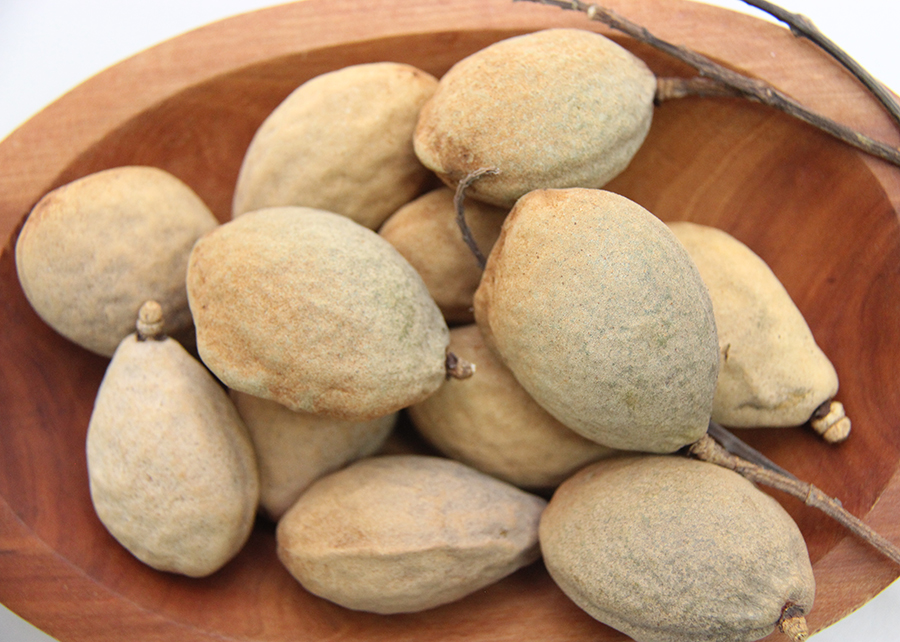
The demand for baru has increased in Brazil and abroad
-
A native tree from the Cerrado that is only found in South America, the baru tree can supply timber and an edible seed, baru. -
Research has been developing a baru production process in integrated crop-livestock-forestry systems. -
Similar to a nut, the market value of baru has been increasing, as it is sought after by national and international cuisines. -
Half of the national baru production is exported; exports are divided especially between the United States and Europe. -
The use of baru in integrated crop-livestock-forestry systems is a more interesting option for farmers than monoculture. Present production is still mainly extractivistic. |
The baru tree (Dipteryx alata), which is native to the Cerrado biome, is one of the most promising native species for use in integrated crop-livestock-forestry systems, in which grain crops, trees and herds are produced in the same space. Presently, the eucalyptus tree is the most widely used one in these systems. However, the baru tree has an advantage: in addition to the wood that the tree produces, it also produces a valuable seed. The baru, cumaru or cumbaru, as it is locally known, is similar to a nut, and demand for it has increased for the last few years in Brazil and abroad. Consumption is forecast to grow 25% a year for the period between 2019 and 2029, according to an article published in the market research journal Fact.MR.
Brazil is the main country to produce this species. Almost half of the seeds produced is sold abroad, 25% to Europe and 22% to the USA. One of the reasons for the increase in sales of the product, according to the publication, is the demand for healthy foods. Baru is known to be a superfood, for its high nutritional value (see the table).
This scenario can increase incomes in rural communities, since nearly all the fruits come from extractivism. However, such demand can become greater than what Brazil can provide. Because of this, it is necessary to develop commercial baru plantations. This will make it possible to increase production and farmers' income, analyzes Embrapa Cerrados researcher Fernando Rocha, project leader to evaluate native species – baru, mangaba and pequi – in integrated crop-livestock-forestry systems.
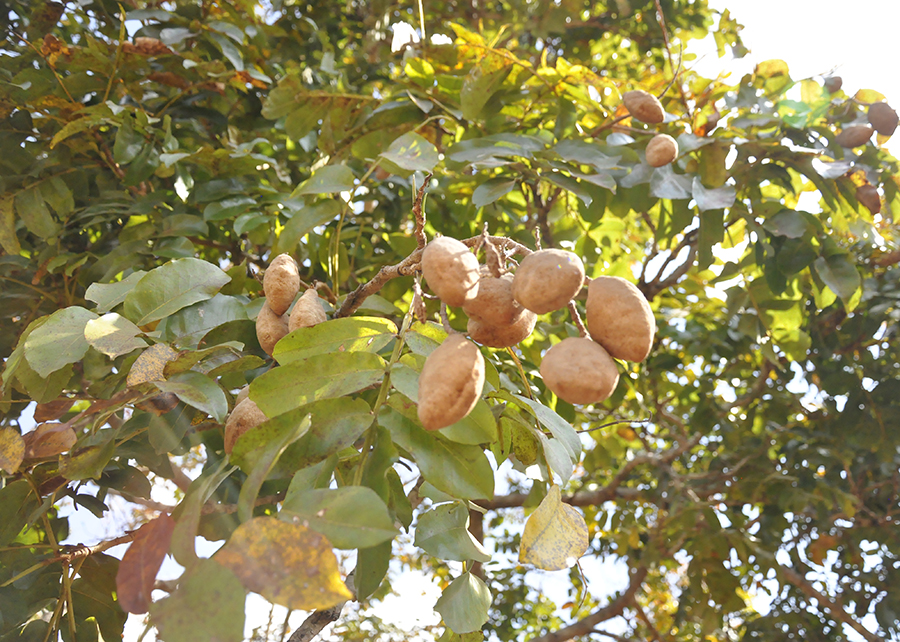
The recommendation of the baru tree for use in integrated systems considered several aspects, including the economic potential of the tree. "Baru can be another source of income for farmers. The plant has bearing and adequate physical characteristics. Growers can sell the fruits and also obtain wood, which is of fine quality and can bring them considerable income", explains researcher Maria Madalena Rinaldi.
Rocha states the tree also has recognized potential for use in areas that are used for livestock production. “There is evidence that the baru tree will function in integrated systems. When farmers clear up an area, they remove all the trees but leave the baru trees. It is one of the few trees that they leave in their pastures”.
In addition to benefiting from the shade, the animals feed off the fruits. The research recommendation to include the baru tree in integrated systems considers the low feasibility of implanting it in monocultural areas. "Intercropping baru with other crops is more feasible", he says.
| More nutritional than most nuts The baru nut has more nutrients than peanuts and most nuts. Almost 30% of its weight is made up of protein. It is also rich in vitamin C, iron, polyphenols, flavonoids, and anthocyanins and hence it is presented as a functional food. The whole fruit can be used. The pulp contains carbohydrates, lipids, protein, fibers and ashes, and it can be added to recipes for breads and cakes to increase their functional quality. The most internal part of the fruit (endocarp) can be used as coal with high ability to produce heat. |
Advances in the production of seedlings
One of the main challenges for the domestication of the baru tree is the production of quality seedlings. Presently, there is no developed methodology for asexual reproduction, which ensures that new plants have the same characteristics of the mother plant, something that does not happen when the seedlings are produced from seeds.
“The development of a protocol to produce clones of baru trees is very important when we think of commercial plants. When there is a good plant that is cloned, it is very likely that the clone will be of excellent quality too", explains Embrapa researcher Wanderlei Lima. Results of experiments underway are very promising.
With grafting, the seedlings' success rate can go up to 60%. The seedlings produced from seeds were used as rootstock: part of the plant where the material of another plant is inserted in order to obtain the same characteristics.
“This study brings unpublished techniques for everyone. We are very optimistic that grafting will be a feasible technique for the baru tree”, he says. The next step is to improve the process using the experience acquired in the first experiment and reach between 80% to 90% success rates. “I believe that if we improve the techniques, we will get to a methodology for asexual reproduction”, Lima says.
In 2019, he and the other project collaborators, Fernanda de Morais and Vicente Moreira, started experiments with cutting, that consists of using part of the selected tree and inducing the formation of roots and of the part of the aerial part to generate a new plant.
“We used woody branches, sprouts and growth regulators to see if the rooting would succeed. We generated four seedlings that will be used in another experiment. Everything that we are doing has never been done before. Until today, no methodology for this technique with the baru had existed.A baru seedling resulting from this technique had never been presented before", he said.
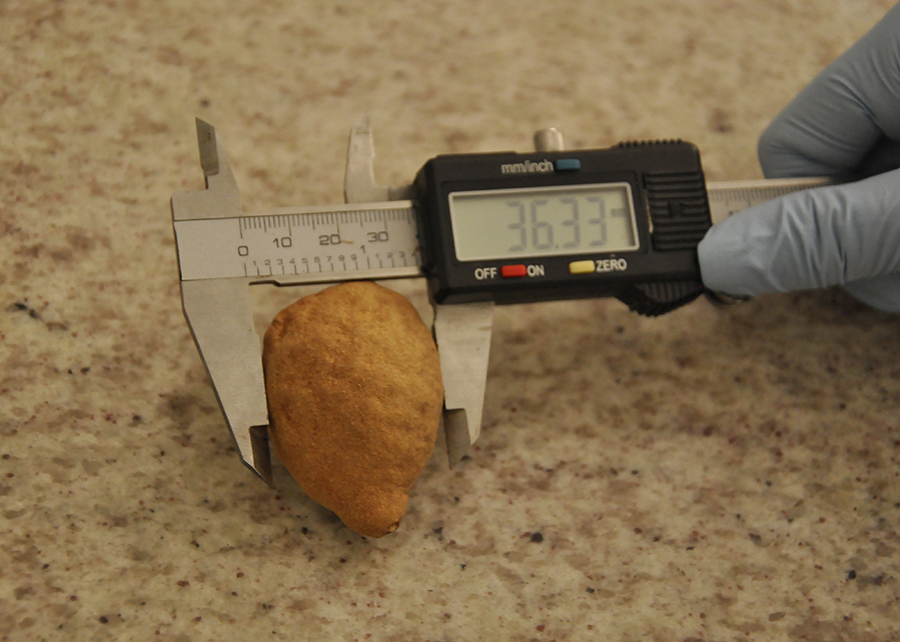 The search for good seeds
The search for good seeds
We began characterizing the fruits and seeds. We need good seeds to have good seedlings. Rinaldi explains that a successful crop begins with a seed that will enable multiplication. For this, she evaluated the fruits of the 2019 crop from Embrapa Cerrados' experimental area and the samples of trees selected by agroextractivist workers from Arinos, Minas Gerais state.
The total production of the experiment at Embrapa Cerrados was analyzed, with 1932 samples, as well as 300 samples from Arinos. The fruits and the seeds were evaluated regarding their size, shape and if they had seeds. The larger the size of the fruits, the larger the probability of yield in terms of pulp and of superior seeds. Size homogeneity is another desirable characteristic.
The results showed that the trees of the Embrapa experiment presented considerable differences with respect to production and viability of fruits and seeds as well as physical characteristics. However, there was no difference in the composition of the seeds from both locations where the seeds were collected, the Federal District and Minas Gerais.
“We sought out plants with desired characteristics, like good quantity of protein in seeds, and functional traits as well, such as Vitamin C levels, anthocyanins and flavonoids”, said the researchers. The harvests of 2020 and 2021 will undergo the same analyses, and this will generate consistent data on the baru fruits and seeds.
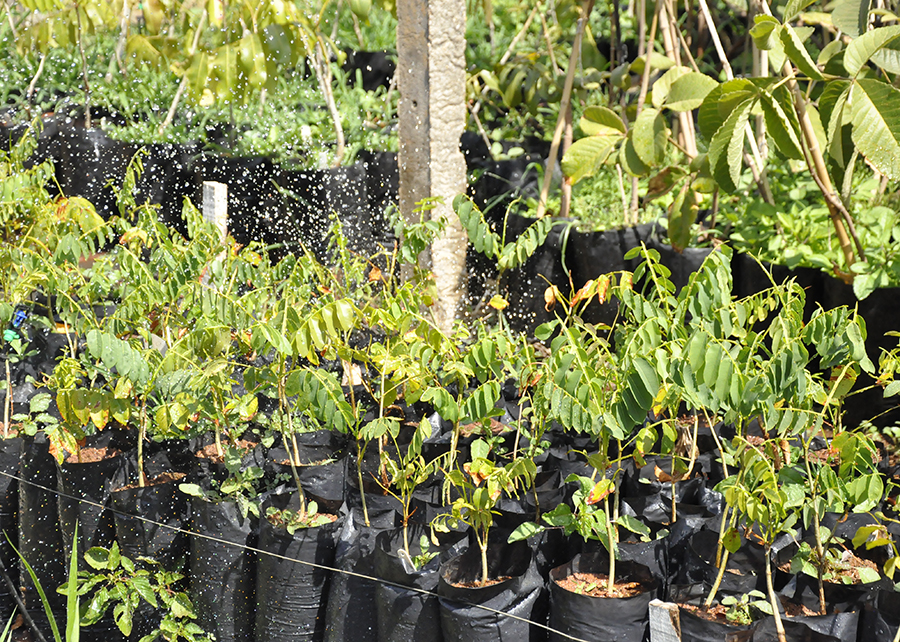 New experiments
New experiments
About 440 seedlings are about to be taken to the field, to a three-hectare area at Embrapa Cerrados. This will be one of the first experiments of integrated crop-livestock-forestry systems in Brazil with a Cerrado native fruit species. The seeds that were used came from one parent plant from Embrapa Cerrados and ten from Arinos.
“We will see how the tree will behave in the system. First, we will grow soybeans or sorghum, depending on the planting period, and then we will grow annual crops. Lastly, we will plant pastures in order to insert the animals in the area", says researcher Karina Pulrolnik.
The baru is a species that is born relatively well. It is important to use seeds of fruits that were recently picked and well stored.”, says researcher Tadeu Graciolli. In order to create the seedlings he prepared substrate with earth and coconut fiber and used slow-release fertilizer. In a new project, Graciolli will study the formulation of specific substrate for the baru.
This year will also see the first experiment with fertilization tests in order to define fertilization and soil correction levels for the baru tree. “We always hear people saying that it is not necessary to fertilize native species because they are already adapted to the conditions of the soil of the Cerrado. But we will test to see if it is possible to improve plant results,” explains researcher Helenice Gonçalves, responsible for the activity.
For this experiment, she says that 800 seedlings were produced with the help of assistant José Cardoso. The seeds were sown in substrates with soil and manure. Afterwards, they were transferred to larger packages with limestone, nitrogen, phosphorus and potassium enriched substrate fertilizer (NPK).
For Rocha, commercial cultivation of native species requires care just like any other crop like an orange or apple grove does in order to obtain suitable yields. They need to be fertilized, irrigated and must undergo weed, pest and disease management.
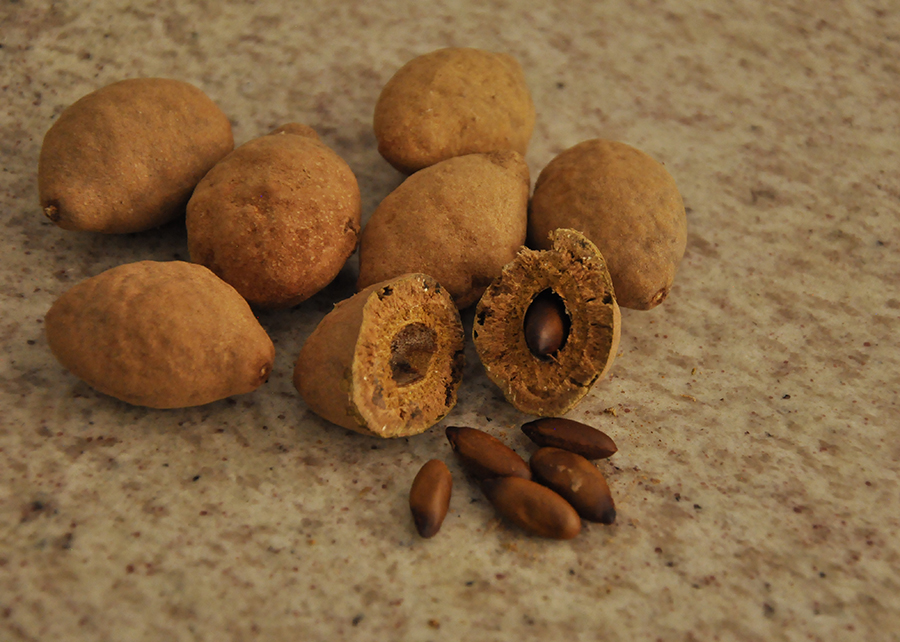 Baru is sustainable and profitable Baru is sustainable and profitable
“The baru trade is a sustainable activity, since it is not necessary to cut the tree down to obtain the fruit”, says Kolbe Soares, conservation analyst at WWF – Brazil. He says that there are more than 700 baru species in the Cerrado that make sustainable exploration possible. "The foreign market is discovering pequi, baru, babassu and crafts done with capim dourado (Golden Grass). Products from extractivist communities have reached the domestic and foreign markets", Soares says. Regarding baru, Soares says that it is being presented alongside other Brazilian nuts that are already well known abroad, such as the Brazil nut and the cashew nut. According to the Brazilian Institute of Geography and Statistics (IBGE), baru production in 2018 totaled 95.8 tons, in the states of Goiás and Mato Grosso, and 69.3 tons in 2019. The minimum price per kilo, established by the National Supply Company (Conab) is of 25.50 reais, but sales at the price of up to R$80.00 have been recorded for those harvests. The increase in the demand for baru has an explanation: the increase in the awareness of consumers regarding the products they consume. This option presents great impacts for the country. “Communities use native species to generate income and at the same time preserve the biome. This also keeps people in the countryside, diminishing rural-urban migration. The increase in demand strengthens the activity and diminishes deforestation pressures in the Cerrado, and all of this turns into a cycle of benefits for society", says Soares. Researcher Fernando Rocha believes that the baru definitely already has national and international demand. For this, he says it is very important to develop a production system to ensure the product’s supply and avoid that this takes place in another country, similar to what took place with the macadamia nut: native to the Pacific islands (Oceania), the selection of materials and the development of methodologies to commercially plant the nut took place in Hawaii, USA, in the 19th century. |
 Ingredients from the Cerrado become stars of gourmet cuisine Ingredients from the Cerrado become stars of gourmet cuisine
In order to celebrate Brasilia’s anniversary, chef Dudu Camargo created a dish with regional ingredients: yellow hake fish with tangerine and Perola do Cerrado passion fruit sauce, accompanied by creamy baru rice and savory baru flour on the side. For those who do not know it, the post of the dish on Instagram says that the baru is a nut that is native to the Cerrado and still very little known, and the post says that “nothing does more justice than using local ingredients in order to honor our city, that enchants people for its beauty and unique spices". Like Dudu, several other chefs in the capital have given ingredients from the biome special status on their menus, and not only in salty dishes. There is the drink caipirinha made with pequi, sweet pizza with baru, and ice cream made with Cerrado cashew. Making ingredients from the Cerrado more popular is also the goal of chef Vinicius Rossignoli. After attending the 2018 edition of MasterChef, a TV show, the native of Goias specialized in using resources from his native biome, and presently is one of the Cerrado’s gastronomic references. In his work, he prepares different dishes for high level officials and influencers in search of support for projects that will strengthen his goal of rescuing our culture and valuing our biodiversity. He believes that presenting unique and different flavors of native products can lead to the preservation of species. “Gastronomy is how we understand conservation. When there is consumption, then there is production and conservation. The Cerrado has unparalleled riches that few know of”, he says. In 2020, Leonardo Antunes, owner of a network of pizzerias in the Federal District, also put his bets on species from the Cerrado in order to diversity his menu. Rossignoli was responsible for training pizza chefs of the city to come up with recipes with products from the region. The result was 13 new pizzas. Of these, six were selected from a jury to be included in the menu. “It was a tough competition, and the result was above our expectations” he says. The choice of pizza seems obvious. “Pizza is one of the most democratic dishes. Everyone loves pizza. We take the ingredients of the Cerrado, that are now very well known, and put them on a dish that is very popular for people to try”, the chef says. The idea was a success. Today the pizzas from the Cerrado represent 30% of the requests, even though they represent 10% of the varieties that are available for clients. “In all places of the world, gastronomy values local ingredients. In Brazil we need to do the same, we must value what is ours. Doing this, we will have fresher foods. With the flavors of the Cerrado, I know we will be on the right path, says Antunes. Photo: Fábio Reynol (Chef Vinícius Rossignoli) |
Juliana Miura (MTb 4563/DF)
Embrapa Cerrados
Press inquiries
cerrados.imprensa@embrapa.br
Phone number: +55 61 3388-9891
Translation: Margit Guimarães
Embrapa Cerrados
Editing (English): Mariana Medeiros (13044/DF)
General Secretariat
Further information on the topic
Citizen Attention Service (SAC)
www.embrapa.br/contact-us/sac/
 The search for good seeds
The search for good seeds New experiments
New experiments

